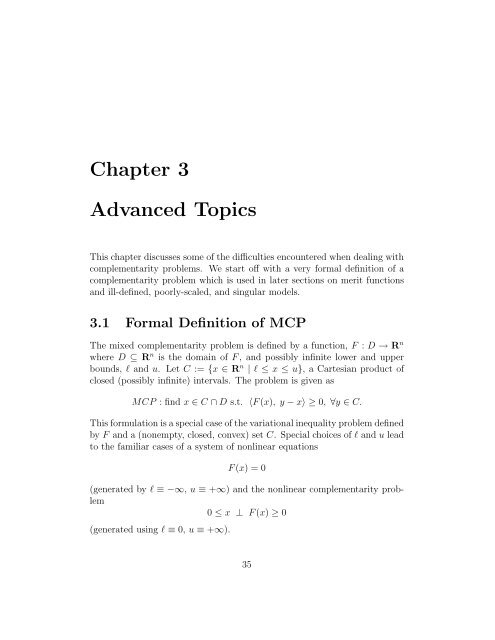GAMS/PATH User Guide Version 4.3
GAMS/PATH User Guide Version 4.3
GAMS/PATH User Guide Version 4.3
You also want an ePaper? Increase the reach of your titles
YUMPU automatically turns print PDFs into web optimized ePapers that Google loves.
Chapter 3<br />
Advanced Topics<br />
This chapter discusses some of the difficulties encountered when dealing with<br />
complementarity problems. We start off with a very formal definition of a<br />
complementarity problem which is used in later sections on merit functions<br />
and ill-defined, poorly-scaled, and singular models.<br />
3.1 Formal Definition of MCP<br />
The mixed complementarity problem is defined by a function, F : D → R n<br />
where D ⊆ R n is the domain of F , and possibly infinite lower and upper<br />
bounds, ℓ and u. Let C := {x ∈ R n | ℓ ≤ x ≤ u}, a Cartesian product of<br />
closed (possibly infinite) intervals. The problem is given as<br />
MCP : find x ∈ C ∩ D s.t. 〈F (x), y− x〉 ≥0, ∀y ∈ C.<br />
This formulation is a special case of the variational inequality problem defined<br />
by F and a (nonempty, closed, convex) set C. Special choices of ℓ and u lead<br />
to the familiar cases of a system of nonlinear equations<br />
F (x) =0<br />
(generated by ℓ ≡−∞, u ≡ +∞) and the nonlinear complementarity problem<br />
0 ≤ x ⊥ F (x) ≥ 0<br />
(generated using ℓ ≡ 0, u ≡ +∞).<br />
35

















